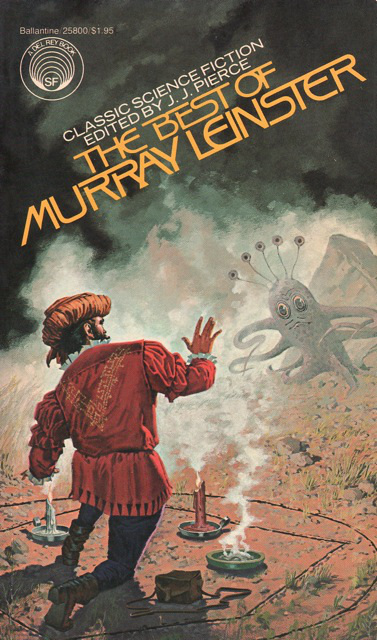While I work on a review of a World War One history book, the pulp series continues.
Raw Feed (1999): The Best of Murray Leinster, ed. John J. Pierce, 1978.
“The Dean of Science Fiction”, John J. Pierce — Besides being a brief summation of the stories in this collection, this introduction talks about Leinster’s themes and career. It also relates some surprising information about Leinster. His first story (a fantasy) was written in 1919 (no date for his last work is given – he died in 1975). He converted to Catholicism, and it relates information I knew already – Leinster’s career as an inventor of the optical Jenkins Systems used as a rear projection system in movies and tv. [Leinster’s actual name was William Fitzgerald Jenkins.] Leinster also emphasized rationality and was an admirer of Thomas Aquinas.
“Sidewise in Time” — This story is the original reason I bought this collection. It’s generally credited as being the first parallel universe story, and it holds up very will since its publication in 1934. Later on this type of story was rationalized with, as in Frederik Pohl’s The Coming of the Quantum Cats, the many worlds interpretation of quantum physics. Here Leinster introduces some twists on the notion that many later writers didn’t. First, his plot does not simply have a character or characters leave their own timeline willingly or unwillingly. Leinster introduces the notion of a tile-work Earth where each bounded area enters a different parallel universe than its neighbors do. One world has a strong Viking presence, another has China settling North America, another universe still has dinosaurs, in another the Roman Empire still endures, and in another the South won the Civil War. Leinster’s main character is a mathematician, Professor Minott, who is the only person who knows a cosmological upheaval, which eventually thrusts a quarter of the Earth’s surface into other universes, is about to take place. But he tells no one. He hopes to use the event to become more than just a mathematics instructor in an obscure community college. He wants to find a universe where his knowledge and technology can make him king – and husband of one of his students. His attempts to do this are fascinating as are the alternating sections showing what happens to some when their homes are suddenly bounded by other universes. Eventually, the students Minott tricks into joining him on his adventure (and they don’t follow him willingly for long) leave him except for a female student with a crush on him. The universe settles down, but the story ends with not all the tiles returning to their proper timelines. This is the first example of a parallel universe story and still holds up well. Leinster puts forth many intriguing alternate histories and works out or hints at the implications of his idea, and I liked the notion of a man who seeks to use such a cataclysm to gain respect and power. It’s a very human idea.
“Proxima Centauri” — This is, in its notion of sentient vegetable men, a pulpy story in conception, but Leinster carries it off well, and there are several elements which make it a sophisticated sf tale, especially one published in 1935. Leinster takes some trouble to describe the construction of an artificial ecosystem in his interstellar ship. That, the inclusion of crews’ families to facilitate morale, and a mutiny from the psychological effects of a seven year voyage to the next star were all, I suspect, novel in 1935. Leinster does a credible job rationalizing, via atomic physics, his starship drive but it’s still unworkable. The vegetable men of Proxima Centauri seem brutal, but Leinster cuts them some slack by rightly pointing out that that aliens made of precious metals would probably be met the same way by Earth men, and he tries to construct a biological rationale (which doesn’t really work but it’s the attempt that makes it sf) whereby these mobile plants need animal flesh to live and how it excites them (they’re destroyed just about all animal life on their world). Actually, they’ve learned to live on vegetable matter but instinctually still crave animal products. This may also be one of the first sf stories to introduce an alternative to a fire and metal technology: the Centaurians mold protoplasm to their ends. I liked the human commander, at story’s end, contriving to get all the Centaurians to return to their home world to eat their Earth trophies and celebrate a new source of animal matter. Then he blows the planet up with a sabotaged starship engine.
“The Fourth-dimensional Demonstrator” — An ok, humorous story of the screwball comedy sort involving a matter duplicator. We have a broke playboy, a kangaroo, a gold-digging dancer, and it was published in 1935.
“First Contact” — The first and only other time I’ve read this story I wasn’t very impressed even though it’s widely regarded as a classic, included in The Science Fiction Hall of Fame, and even provoked a critical answer (“The Heart of the Serpent”) by Soviet sf writer Ivan Yefremov (in which the central problem of this story is because both aliens and humans are good communists). I appreciated it much more the second time around. The biggest reason is its kinship (and, perhaps, inspiration for) George Zebrowski and Charles Pellegrino’s wonderful The Killing Star. Both stories make the justifiable point (Pellegrino’s and Zebrowski’s novel goes into more a detailed rationale including evolutionary history) that intelligent spacefaring races would share similar traits and similar paranoia and similar motives to launch a preemptive attack against each other as potential competitors. The one flaw in Leinster’s story is that he, perhaps, repeats why the races can’t trust each other too often. The concern that human and alien have in not revealing their homeworld may have partially influenced Larry Niven’s “Neutron Star”. I like both races amiably meeting each other and agreeing they’ll probably have to kill each other. The solution to the quandary is justifiably famous. Human and alien switch ships thereby insuring dismantling of weapons and tracking systems and the removal of vital maps.
“The Ethical Equations” — Another first contact story from Leinster. He seems to have made something of a specialty of them. It’s an interesting story with its gimmick based on odd, unstable isotopes (thermally unstable – I don’t know how plausible that is) and another, like Leinster’s “First Contact”, example of warily meeting aliens though here they are in suspended animation. The Ethical Equations, physical laws which cause coincidence to reward ethical behavior and punish bad behavior, are an interesting notion. While I certainly don’t expect Leinster to thoroughly explicate this conceit, which is pure moral fantasy, (anymore than I expect the many ftl drives in sf to be realistic, workable, and fully detailed), I would have liked a bit more background information on how they allegedly manifest themselves. This is sort of a thematic variation on the end of “First Contact”.
“Pipeline to Pluto” — Three interesting ideas in this story. The first is a virtual pipeline between the Moon and Pluto composed of cargo carriers launched daily at each location. The second is the notion of technological possibility trumped by political and economic factors. Here passengers can ride these tugs cheap, but it’s illegal because of lobbying efforts by passenger lines. (Thus rationalizing the plot of smuggling people to labor starved Pluto – people who are flash frozen en route.) Third is the notion of surviving, in great pain, the freezing process. Leinster tells this revenge tale in a moody tone.
“The Power” — Another first contact story by Leinster. Here a dying alien, survivor of an expedition to Earth decides to dictate his knowledge to a medieval heremetic alchemist. The effect of iron on the alien technology seemed implausible given iron’s relative plentifulness in the universe. Leinster probably made it deleterious to the alien technology in order to reconcile his plot with bits of medieval folklore) . Of course, the alchemist understands almost none of the tale due to his ignorances and prejudices. The modern physicist reading the alchemist’s writings echoes, at story’s end, our exasperation at not having the specific scientific knowledge of the alien instead of just medieval vagueness: “Damnation! Where is the rest of this stuff.” What makes the story interesting (and perhaps reveals Catholic Leinster seeing man as perpetually flawed) is that the alchemist isn’t just some scholarly, harmless seeker of knowledge out of his league. He’s an ambitious, egotistical, power hungry man who is perfectly willing to deal with what he thinks is a demonic power (who he betrays at story’s end) to further his ends.
“A Logic Named Joe” — I’d heard of this justifiably famous short story for several years, but it was only after reading a letter in Skeptical Inquirer claiming that Jenkins predicted the Internet that I really wanted to read it. The letter was right. Leinster did predict something close to the Internet (pretty remarkable considering sf’s abysmal record of predictions, particularly in regard to computer technology) in 1946, very shortly after digital electronic computers made their appearance. Of course, the technical names are completely different, but Leinster did a remarkable job of prediction, especially in regard to the social problems of the Internet. Jerry Pournelle has asked what happens to civilization and society when you can get the answer to any question you want. That question is at the heart of this story when a logic named Joe decides, after randomly developing sentience, to turn the ubiquitous household logic service from a mere consulting to a directive service. Joe orders the network of logics to answer questions on how to develop new technologies and commit perfect crimes, list complete dossiers on people, and evade the “censor block”. The latter two elements touch on two concerns of the contemporary Internet: privacy and filtering services. (Joe isn’t malicious. He just wants to provide a better service.) Even the technology is remarkably close. Household logics have monitors and screens like computers (different jargon, of course). They are hooked up to a “tank and integrator set-up”, rather similar to a modern computer server, to provide a variety of reference and commercial services, and the logics can do math and accounting. Leinster erred a bit in having his tanks have “all the facts in creation” and recordings of all telecasts (a dream for the Internet, now), and it’s not entirely clear if each tank has the same data or if they are networked in the sense of the Internet (they are connected to each other). It’s a classic bit of informed prediction tied to a compelling story. Joe haunting a computer network is a foreshadowing, almost 40 years later, of the more sinister sentient hauntings of networks in Vernor Vinge’s True Names and John Varley’s “Press Enter ”.
“Symbiosis” — The central concern of this story, biological warfare, and its setting, the fictitious country of Kantolia overrun by an oppressive neighbor (obviously the Soviet Union, unchecked by the United Nations), probably accounts for this story not being published in a sf magazine but a 1947 issue of the general interest Colliers. It’s an interesting story built around the notion of a country inventing a vaccine which enables a symbiotic relationship between the human body and a mutant form of a diplococcic bacteria. Kantolia, upon being invaded, releases the bacteria against which its population is protected. The invaders, after heavy losses due to disease, retreat. It’s an interesting notion. But Leinster’s ending, where it is implied that Kantalia’s voluntary sharing of this technology with peaceful countries to ensure permanent peace is way too pat. Other countries could develop a competing technology, steal the secret, or force it out of Kantolia or, of course, betray Kantolia after getting the immunization. Perhaps Leinster wanted to explore the morality and moral implications of such a non-aggressive defense rather than create a realistic one.
“The Strange Case of John Kingman” — This story, with its delving into historical records to uncover the secret of a mental patient committed for 162 years, reminded me of H. P. Lovecraft. It’s a clever story. The normal course of this story would be to end it upon revealing the man is an alien. But Leinster takes it further. Kingman is an alien, all right, but he’s an insane alien with a god complex, and he refuses to communicate the technological and scientific knowledge he must possess. An attempt to cure him seems to work until it’s revealed he’s reverted to, for him, child-like IQ of 90 and has developed amnesia.
“The Lonely Planet” — An odd, sort of super science tale from Leinster. It features a vast, planet covering organism called Alyx. Alyx is telepathic and can absorb the memory, knowledge, and skills of the intelligence she contacts. It also can be directed telepathically. The story depicts its evolution from a planet covering organism to sentient organism after meeting a Space Patrol expedition. Yet, despite battling the Space Patrol which fears its intelligence, Alyx craves the human contact which created and shaped its mind. The story is also a bit of a mild satire against organizational mindsets. The Haslip family has a long, multigenerational relationship with Alyx, a relationship virtually unacknowledged in official records though the Haslips made crucial discoveries about Alyx. John Haslip XXII is purged from history because he refused to kill Alyx, who goes on to team up with his expedition and make travel to the Second Galaxy possible.
“Keyhole” — An ok story about a study of lunar beings to determine how to kill them and save the colonization effort. At story’s end, it’s revealed the aliens are telepathic, quite clever, and have been studying the psychologist sent to study them.
“Critical Difference” — An engagingly grim story set on a cold colony world. The race to save a world’s population from an impending ice age was good as well as the protagonist’s struggles in his very first independent survey command. Even the love story between Massy and Riki was handled well and also the psychology of people facing their own death and the death of their world and of their family. The concept of Lani III’s climactic changes proceeding Lani II’s (the heavily populated planet) by 200 hundred days was logical and exciting. The technology for extracting electrical energy from the atmosphere was plausible sounding, well worked out, and interesting (as was priming the pump, at story’s end, with sodium and potassium vapors) though probably not theoretically possible (I’m guessing). I think I also detected another link between Larry Niven and Murray Leinster. Niven’s “Inconstant Moon”, like this story, involves the sudden and disastrous discovery that your star is a long term variable.
More reviews of fantastic fiction are indexed by title and author/editor.
Advertisements Share this:




